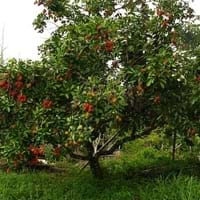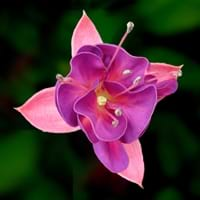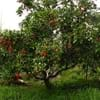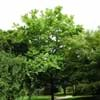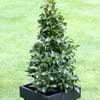Life Span
Perennial
Perennial
Type
Tree
Tender Perennial
Origin
Southeastern Asia, China
Caribbean
Types
Brewster, Mauritius, Hak ip
Fuchsia Decidua, Fuchsia Fulgens, Fuchsia Splendens, Fuchsia Microphylla
Number of Varieties
Not Available
Habitat
Subtropical climates, Tropical regions, Warmer regions
Forest edges, Woods
USDA Hardiness Zone
10-11
9-10
Sunset Zone
H1, H2, 21, 22, 23, 24
16, 17, 23, 24
Habit
Oval or Rounded
Arching/Fountain-shaped
Flower Color
Light Yellow, Yellow green
Orange Red
Flower Color Modifier
Bicolor
Not Available
Fruit Color
Red, Magenta
Not Available
Leaf Color in Spring
Red, Dark Green, Copper
Purple, Dark Green
Leaf Color in Summer
Dark Green
Purple, Dark Green
Leaf Color in Fall
Dark Green
Purple, Dark Green
Leaf Color in Winter
Dark Green
Unknown
Leaf Shape
Long Linear
Long Linear
Plant Season
Spring, Summer, Fall, Winter
Spring, Summer, Fall, Winter
Sunlight
Full Sun, Partial Sun
Full Sun, Partial Sun, Partial shade
Type of Soil
Loam, Sand
Clay, Loam, Sand
The pH of Soil
Acidic, Neutral
Acidic, Neutral
Soil Drainage
Well drained
Average
Bloom Time
Early Spring
Indeterminate
Tolerances
Not Available
Drought
Where to Plant?
Ground
Container, Ground, Pot
How to Plant?
Seedlings, Stem Planting, Transplanting
Seedlings, Stem Planting, Transplanting
Plant Maintenance
High
Medium
Watering Requirements
Requires regular watering
Requires regular watering
In Summer
Lots of watering
Lots of watering
In Spring
Twice a week
Moderate
In Winter
Regular watering required
Average Water
Soil pH
Acidic, Neutral
Acidic, Neutral
Soil Type
Loam, Sand
Clay, Loam, Sand
Soil Drainage Capacity
Well drained
Average
Sun Exposure
Full Sun, Partial Sun
Full Sun, Partial Sun, Partial shade
Pruning
Prune after harvesting, Prune lower leaves, Prune to control growth
Prune in spring, Prune lower leaves, Remove dead or diseased plant parts, Remove deadheads, Remove shoots
Fertilizers
All-Purpose Liquid Fertilizer, Fertilize after blooming period
All-Purpose Liquid Fertilizer
Pests and Diseases
Aphids, fungus, Leaf curl
Rhizoctonia Root Rot, Rust
Plant Tolerance
Not Available
Drought
Flowers
Insignificant
Yes
Flower Petal Number
Single
Single
Foliage Texture
Medium
Medium
Foliage Sheen
Glossy
Matte
Attracts
Not Available
Hummingbirds
Allergy
Itchiness
Asthma, Hay fever
Aesthetic Uses
Showy Purposes
Showy Purposes
Beauty Benefits
Not Available
Not Available
Environmental Uses
Not Available
Air purification
Medicinal Uses
anti-allergy, Bone strength, Digestive disorders, Heart problems
Not Available
Part of Plant Used
Fruits
Flowers, Fruits
Other Uses
Used As Food, Used as Ornamental plant
Not Available
Used As Indoor Plant
No
Yes
Used As Outdoor Plant
Yes
Yes
Garden Design
Edible, Feature Plant, Foundation, Fruit / Fruit Tree, Hedges, Shade Trees, Topiary / Bonsai / Espalier, Tropical
Bedding Plant, Container, Feature Plant, Foundation, Hedges, Tropical
Botanical Name
LITCHI chinensis
FUCHSIA triphylla
Common Name
Litchee, Litchi, Lychee
Fuchsia
In Portuguese
lichia
Fúcsia
Phylum
Tracheophyta
Magnoliophyta
Class
Magnoliopsida
Dicotyledonae
Order
Sapindales
Myrtales
Family
Sapindaceae
Onagraceae
Genus
Litchi Sonn
Fuchsia
Clade
Angiosperms, Eudicots, Rosids
Angiosperms, Eudicots, Rosids
Tribe
Not Available
Not Available
Subfamily
Sapindoideae
Not Available
Properties of Lychee and Fuchsia
Wondering what are the properties of Lychee and Fuchsia? We provide you with everything About Lychee and Fuchsia. Lychee doesn't have thorns and Fuchsia doesn't have thorns. Also Lychee does not have fragrant flowers. Lychee has allergic reactions like Itchiness and Fuchsia has allergic reactions like Itchiness. Compare all the properties and characteristics of these two plants. Find out which of these plant can be used as indoor plant. If you are interested to decorate your house and garden, find out aesthetic uses, compare them and select the plant which will beautify your surrounding. Along with beautification, try comparing medicinal and edible uses of Lychee and Fuchsia and you can choose the plant having best and most benefits.
Season and Care of Lychee and Fuchsia
Season and care of Lychee and Fuchsia is important to know. While considering everything about Lychee and Fuchsia Care, growing season is an essential factor. Lychee season is Spring, Summer, Fall and Winter and Fuchsia season is Spring, Summer, Fall and Winter. The type of soil for Lychee is Loam, Sand and for Fuchsia is Clay, Loam, Sand while the PH of soil for Lychee is Acidic, Neutral and for Fuchsia is Acidic, Neutral.
Lychee and Fuchsia Physical Information
Lychee and Fuchsia physical information is very important for comparison. Lychee height is 910.00 cm and width 1,070.00 cm whereas Fuchsia height is 45.70 cm and width 45.70 cm. The color specification of Lychee and Fuchsia are as follows:
Lychee flower color: Light Yellow and Yellow green
Lychee leaf color: Red, Dark Green and Copper
Fuchsia flower color: Orange Red
- Fuchsia leaf color: Purple and Dark Green
Care of Lychee and Fuchsia
Care of Lychee and Fuchsia include pruning, fertilizers, watering etc. Lychee pruning is done Prune after harvesting, Prune lower leaves and Prune to control growth and Fuchsia pruning is done Prune in spring, Prune lower leaves, Remove dead or diseased plant parts, Remove deadheads and Remove shoots. In summer Lychee needs Lots of watering and in winter, it needs Regular watering required. Whereas, in summer Fuchsia needs Lots of watering and in winter, it needs Average Water.
